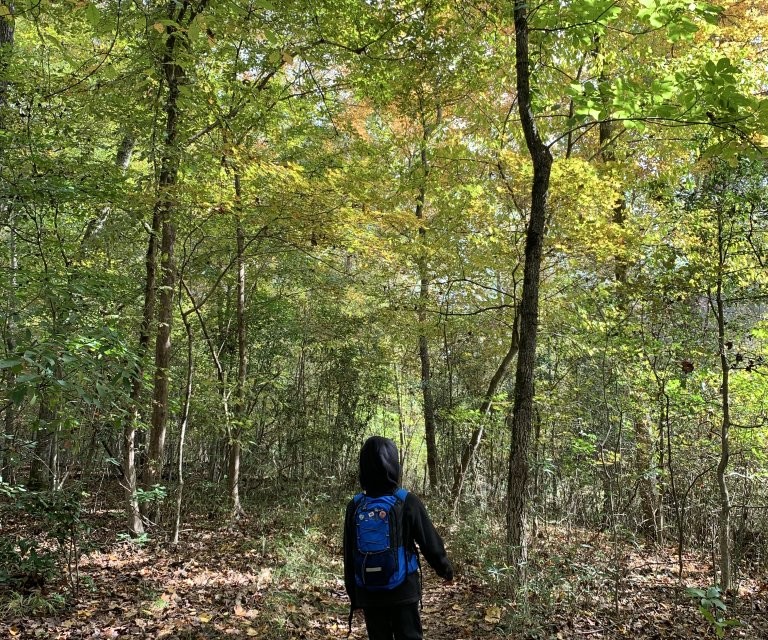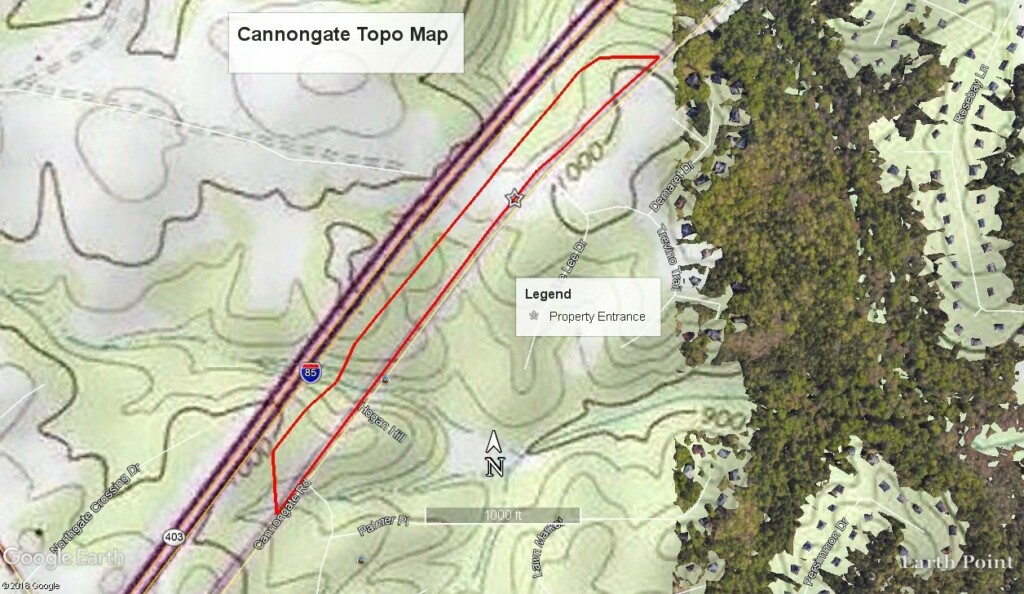Canongate Nature Park
A natural hardwood forest with a hike & bike trail

A lovely park in an unlikely setting
Conservation
The site is only 17 acres and is contiguous with a loud stretch of I-85 as it enters Atlanta. But it is perpetually conserved to remain natural and to have no cost public recreation.
Recreation
It has a very fun 1.75-mile hiking and biking natural surface trail.
Community
The Friends of Canongate Nature Park is forming and will soon host events and volunteer activities at the park.
Project Facebook Page: Canongate Nature Park Facebook page
Support this project: Support Canongate Nature Park
Topography

Soils and geology
The property is found in the Level III ecoregion known as the Piedmont. The Piedmont comprises a transitional area between the mountainous ecoregions to the northwest and the relatively flat Coastal Plain to the southeast. Geologically, it is a complex mosaic of Precambrian and Paleozoic metamorphic and igneous rocks with moderately dissected plains and isolated monadnocks (rounded hills). The soils tend to be finer-textured than in the coastal plain ecoregions. Once largely cultivated, much of this region has reverted to pine and hardwood woodlands, and, more recently, to sprawling urban and suburban areas. Subdivisions of the Piedmont ecoregion in Georgia include the Southern Inner Piedmont, the Southern Outer Piedmont, the Carolina Slate Belt, the Talladega Upland, and the Pine Mountain Ridges.
The Property is more specifically located in the Southern Lower (Outer) Piedmont subsection of the Piedmont Ecoregion of Georgia. The Southern Lower Piedmont ecoregion has lower elevations, less relief, and less precipitation than the Southern Inner Piedmont. Loblolly and shortleaf pines are the major forest type, with less oak-hickory and oak-pine than in the Southern Inner Piedmont. Gneiss, schist, and granite are the dominant rock types, covered with deep saprolite and mostly red, clayey subsoils. The southern boundary of the ecoregion occurs at the Fall Line, where unconsolidated coastal plain sediments overlay the metamorphic and igneous rocks of the Piedmont.
Soils of the Cecil soil series make up approximately 46% (10.5 acres) of the Property soils. Lesser amounts of Pacolet and Madison soils (7.0 acre) also occur on the property and 1.2 acres occur as Riverview-Chewacla along the minor intermittent stream course. USDA/NRCS classifies farmland as to relative value for agriculture. These classes include Prime Farmland and Farmland of Statewide Importance. The soils of the property are classed as not prime farmland, except for the Riverview-Chewacla, which is classified as Farmland of Statewide Importance. This series is also rated as a low-level hydric soil.
Water resources
The property contains a minor intermittent branch that flows into Persimmon Creek. This then joins Shoal Creek and then flows into Line Creek, which is a tributary of the Flint River. The Upper, Middle, and Lower Flint River are designated as High Priority Species and Aquatic Community Species Streams by GA DNR.
The small intermittent branch head on the property is dry most of the year, and it is rated as minimally hydric for agricultural purposes.
Vegetation and habitat
The approximate acreages of each area and habitat type are as follows: oak hickory pine forest (approximately 18.7 acres); open land for parking area (0.1 acres). Oak Hickory Pine Forest occurs on this property and is listed as a high priority habitat in the Piedmont Ecoregion of Georgia by GADNR SWAP documents.
The oak hickory pine forest is located over the whole tract and contains mostly 40-plus-year-old trees. The dominant overstory species in this older forest are pignut hickory, southern red oak, white oak, and loblolly pine. Other overstory species include post oak, sweetgum, tulip poplar, and scarlet oak. The midstory and understory include a mix of woody and herbaceous vegetation, such as muscadine vines, sweetgum and oak saplings, greenbrier, winged elm, Japanese honeysuckle, and blackberry. There are small patches, less than 2 acres total, of clusters of loblolly pine. These groupings individually are not large enough to break out from the dominant type and adhere to the type definition of Oak, Hickory, Pine forest.
The only true open area is the parking area noted above. It is currently composed of domestic grasses and native weeds.
The riparian zone is a very small intermittent drain and contains the same vegetative species as the nearby upland.
Exotic plant species were noted on the property, including Japanese honeysuckle, Chinese privet, and crabgrass.
Wildlife
Field signs and individual sightings during the field surveys noted the presence of the common wildlife species of the Piedmont Ecoregion of Georgia. This included raccoons, opossums, gray squirrels, nuthatches, and crows. Other mammals such as wood rats, voles, and shrews may also be present. A variety of native reptiles and amphibians are likely to be here including various non-venomous water snakes, rat snakes, king snakes, fence lizards, copperhead snakes, green tree frogs, and green anoles. Numerous resident and migrant songbirds and other common land birds were seen and heard while inspecting the tract including cardinals, downy woodpeckers, blue jays, and others. Expect to find the normal complement of Piedmont region wildlife given the existing habitat types and surrounding land use.
Rare or endangered species known to exist
The technical teams for Georgia DNR SWAP identified 87 high-priority animal species in the Piedmont ecoregion. These included 17 birds, 3 reptiles, 5 mammals, 3 amphibians, 11 mollusks, 29 fish, 8 aquatic arthropods, and 14 terrestrial arthropods. In addition, 66 species of high-priority plants were identified for the Piedmont.
No endangered or threatened species are known to occur on the property. A full rare species survey was not conducted, but suitable habitat exists for some rare species in the habitat of the property. Among rare and unusual plants for this region, the following are species found in the Georgia DNR SWAP documents that could occur on this site: Cypripedium acaule (Pink ladyslipper) and Symphyotrichum georgianum (Georgia aster)
These animal species of concern known to occur in the region around the property may find suitable habitat in the hardwood forests: Lampropeltis calligaster rhombomaculata (Mole king snake) And additionally, migrants like the black and white warbler, great crested flycatcher, wood peewee, and pine warbler, utilize mixed wood habitat and could be sighted on this property.
Scenic character and views from public roads/waters
The whole length of the property is visible from Cannongate Road, I-85, and developments across the road. There is approximately 0.71 mile of road frontage on Cannongate Road and an equal amount from I-85, where it is visible across the interstate fence.
Existing man-made structures
The following man-made structures were noted on this tract: a graded area for the parking area. See Part 1 Attachment 4 for the locations of these features.
Evidence of past disturbances
No evidence of heavy storms, fires, or other large-scale events was noted during the visit.
Land uses
Former land uses
Evidence of past land use is noted in the surrounding well-established suburbanization. The most noticeable activity in the past 60 years has been earlier timber harvest and subsequent re-growth.
Current land uses
Current land use is to be held for development. This is changing immediately though, and the tract will be held for its natural habitat features, low-impact outdoor recreation, such as hiking and biking. It is also important to the nearby property holders as it serves as a natural wooded buffer to noise from the interstate. No other recent commercial uses have been made of the tract. Casual hiking and wildlife observation by community owners and the public occurs at currently.
Management plan
The overall plan is to use the tract for nature observation, hiking/outdoor recreation, and conservation value. There are no known relevant zoning or plan restrictions currently in force that affect the planned use of this property. The current county tax documents list the tract as R-3, single-family residential. No evidence of hazardous waste was noted during a field visit. The previous landowner obtained a Phase 1 study which indicated no evidence of any issues.
The property is situated within 10 miles of several other protected lands including public- and privately-owned greenspaces and park tracts, though numbers are small considering population density. The protection of additional lands in proximity to existing protected lands will extend wildlife travel corridors, improve habitat availability and connection to the public with a healthy natural environment for nature appreciation.
Summary of conservation values
Values protected include oak, hickory, pine forest. These items were also listed above. Additionally, the healthy, natural woodland provides a restful environment for casual hiking and wildlife appreciation.
This protected property will help conserve the nearby water resources by preventing erosion from land clearing for house lot development. Noted in the Intrenchment Creek Restoration Project and contribute to the protection of the waters of the South River. The waters and environs of the Flint River basin are designated high-priority species and aquatic community streams. Conserving high-priority rivers and streams is of particular importance since the protection of these hydrological systems through enhancement of stream buffers, and reduction of non-point pollution is critical for protecting water quality. Nonpoint-source pollution consists of mud, litter, bacteria, pesticides, fertilizers, and a variety of other pollutants being washed into rivers and streams by rainwater. In addition, the United States Forest Service has recognized the important public benefits provided by privately held woodlands, including the enhancement and protection of ground and surface water quality.
Protecting streams and rivers will also provide valuable riparian habitat to rare or unusual plants and animals occupying these unique areas. Protecting stream buffers will also provide travel and disperal corridors for many of the species needing protection in the surrounding habitats.
Protecting this property provides high-quality natural wildland habitat. The site will preserve valuable natural areas containing high-priority habitats in Georgia, including important habitat combinations for year-round resident songbirds and birds of prey, valuable stop-over, and migration sites for many birds, rare and common, including some neotropical migrants whose numbers continue to decline. Also, the property adds to the limited availability of Protected Lands in this area and provides a valuable scenic and sound buffer between I-85 and the nearby neighborhoods. Additionally, the availability of public hiking and nature appreciation will be maintained and enhanced.
The high priority habitats on the property include Oak, Hickory, Pine Forest.